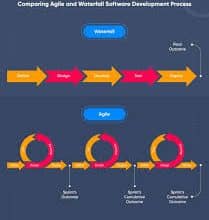Organizations utilize scenario planning as a strategic planning tool to assist in the creation of successful long-term goals. It involves thinking about potential future events and how they might impact a business. To prepare for uncertainty, businesses perform scenario analysis. It aids people in decision-making by allowing them to weigh potential outcomes.
Scenario planning attempts to alienate the two most common errors made by organizations during strategic analysis, which are over-prediction and under-prediction of an organization’s future.
Understanding Scenario Planning
Simply put, scenario planning gives business leaders the ability to plan for unforeseen circumstances and make better-informed business decisions as a result.
Scenario planning tools make scenario planning much easier, as businesses can easily model different scenarios to find the most satisfactory way forward. An organization can be proactive rather than just responding to problems as they emerge by using a scenario planning strategy.
The 7-step scenario planning process includes the steps an organization can take when undergoing scenario planning to better prepare themselves for certain situations before they happen, putting them in a much better position to react when they actually happen.
Types of Scenario Planning
Below are a few types of scenario planning:
#1. Quantitative Scenario Planning
Examining potential scenarios in both the best and worst cases can be helpful. And with quantitative scenario planning, you get just that. Additionally, you can quickly tweak things by changing a number of factors. The most frequent use of this kind of scenario planning is when making financial projections.
Annual business forecasts are also created using quantitative scenarios. These models presuppose that important variables are known and their relationships are fixed.
#2. Operational Scenario Planning
Operational scenarios, often known as event-driven scenarios, focus on the immediate effects a situation might have on a company. In order to control the situation, the decision-makers are forced to make quick judgments or strategic choices.
It is one of the most typical internal forms of scenario planning that a business will conduct and enables businesses to more clearly comprehend the strategic consequences and make appropriate plans.
#3. Normative Scenario Planning
These outline a desired or practicable final result. These scenarios are more focused on goal statements than they are on objective planning. These objectives are more about how the business would like to run in the future than they are about an organizational vision.
The team asks what could elevate the organization’s standing and then generates a list of positive prospects. They then create a list of everything that could go wrong before identifying pessimistic scenarios. Finally, they adopt a normative strategy by generating best-guess scenarios that extrapolate the state of the world now and its reality into the future.
As they offer a summary of changes and a specific list of activities, normative scenarios are frequently used in conjunction with other kinds of scenario planning because they are not usually effective when used alone but when used in conjunction with another type of scenario planning.
#4. Strategic Management Scenarios
This kind of planning, also referred to as “alternative futures,” places more emphasis on how the products or services are used than it does on the organization as a whole. This type of planning is one of the most difficult since it demands decision-makers to have in-depth knowledge of their own organization, the industry, local and national economies, the global landscape, and rivals in order to create a plan that will work.
On the bright side, they provide planners with flexibility in decision-making and a broad mandate for storytelling. Companies occasionally hire analysts or even “futurists,” to help with this sort of planning.
Steps to Performing Scenario Planning
As derived from the scenario planning at Shell, the following steps can be taken when performing scenario planning:
#1. Choose a Time frame
Setting a time frame for your evaluation can help you execute your scenario analysis. Think about your goals while selecting your time frame. Your time frame could be impacted by a number of circumstances, such as:
- The life cycle of your product
- Technological progress.
- The political climate in the country you reside in
- Analyses of your competitors
#2. Identify the Questions you want to answer
Every business is different, as are each model’s specifications. The next steps can be set in motion by identifying the questions you want to address. Typical inquiries are:
- In three, five, or ten years, what technologies will still be relevant?
- How can you prepare for a shifting economic environment in the best manner possible?
- What financial plans should your business make in case of another pandemic?
Even if you begin with a list of predetermined questions, your strategy may vary as you go along. There could be more queries that need to be answered, as you discover.
#3. Identify Driving Forces
Here, we’ll list all the variables at work that might have an impact on your company. We’ll employ a PESTLE analysis to do that. The goal of this investigation is to glean as much information as we can about external factors that might have an effect on your company. The time has come to be meticulous.
Remember that these aren’t required to be bad things, either. It’s important to think about some of the more positive aspects that could still have a significant impact, even if we tend to focus on the things that would affect us the least.
So we begin:
Ø Political
The political component of this examination looks at potential actions by your government or perhaps another country that could have an impact on your company. Although there are regional differences in government regulation, this portion of the study should ultimately be one of the simpler ones. Here are some illustrations:
- There is a 5% increase in your income tax rate (also known as an economic element).
- Increasing “red tape” in the sector.
- A nation on which you depend for manufacturing is embroiled in a trade dispute with the federal government.
- Election of a new ruler
Ø Economic
Anything that has a financial impact on you or your clients falls under the category of economic considerations. These variables may be occurring locally or on a larger scale, which would mean that they would eventually affect you. Here are a few instances:
- The cost of the raw resources you depend on soars.
- Your city’s unemployment rate is increasing.
- The discretionary income of your consumers rises.
- The fluctuating exchange rate between your nation and the one you depend on
Any social, demographic, or cultural issue or event that may have an impact on your firm and its industry is identified in the social component of this analysis, often known as the “Societal” section. Here are a few outstanding instances:
- Your target market’s populace is getting older.
- Health and fitness are garnering increased attention from the general public.
- Social pressure to stay inside is brought on by the pandemic.
- Influencers on social media are quite influential in consumers’ purchasing decisions.
Ø Technological
One of the most powerful forces influencing business over the last year has been technology. All technological and internet-related factors that have an impact on your company are included in these forces. Here are a few instances:
- People can now work from home full-time thanks to video chatting technology.
- The level of automation in your sector is rising alarmingly.
- The growing risk of ransomware and online attacks
- Global internet connectivity has advanced significantly.
Ø Legal
The analysis’s legal considerations look at both internal and external laws, rules, safety regulations, and policies that might have an impact on the general public or your firm. Here are a few excellent examples:
- To stop the COVID-19 virus from spreading, the government has established rigid business hours.
- A COVID-19 outbreak has been detected at one of your facilities.
- You must pay your employees extra as a result of recent employment laws.
- Sanctions prevent you from doing business with a particular nation.
Ø Environmental
The environmental elements identify any changes to your local geography, temperature, or environment. This may be occurring locally or on a global scale. Here are some illustrations:
- Your area is devastated by a significant weather disaster.
- Extreme air or water pollution.
- Customers are actively seeking out efficient, recyclable, or renewable items.
- The average global temperature rises
#4. Identify Critical Uncertainties
Choose two significant risks or uncertainties that could have the biggest impact on your company from your list of driving variables. Then, take each uncertainty’s extremes into account. It can be challenging to pick only two. If you complete the previous step correctly, you will have a large selection of driving elements to choose from. Remember that you can always repeat the procedure to produce a range of outcomes.
It will be simpler if you take into account both the aspects that will have the most influence on your firm and the ones that are most likely to occur within the time limit you’ve set.
Finance executives create a variety of scenarios when a crisis arises to swiftly establish parameters for how the company should react. These scenarios are based on the presumption that certain events will have an impact on the organization’s survival and will consequently cause a series of actions.
To understand the implications for each area of the organization during a crisis, businesses must integrate historical data with potential outcomes. Scenario plans can provide executives with some breathing room to take a step back and consider the economic, political, and environmental aspects. Crisis scenarios must include these aspects in the order they are most important.
#5. Develop Multiple Scenario’s
The creation of the actual scenario is the key task of scenario planning. You must develop a situation based on the characteristics and market trends, as well as each component we have analyzed in the preceding steps. Creating an effective scenario is similar to crafting a scene for a movie. After creating a plot, you must then center your story on it.
Finance teams must identify the advantages and disadvantages of the strategy while developing a scenario and take appropriate action. Creating an effective scenario is similar to crafting a scene for a movie.
#6. Evaluating a Scenario
The scenario team can strike a balance between wild originality and free-form imagination by following a methodical, step-by-step process. Based on your knowledge and experience, you can form an informed judgment.
With your team, assess the effects of each scenario after you’ve created it. In the given time frame, try to ascertain the position your firm is currently in and the possible future. Consider what measures you may undertake to deal with the impending scenario after you have a broad concept of the prospects of your company.
The team must ensure to consider every factor that might have an impact on the problem.
#7. Update Policies and Strategies Accordingly
After you put the scenarios into action for a period of time, you should review your strategic plan and revise the policies to reflect the latest market changes. This should be done periodically to evaluate and update. In accordance with the macro-environmental parameters we previously outlined, market conditions change often.
Your scenarios can aid in decision-making based on the course that your business seems to be on. You can prepare for any necessary adjustments to your firm by considering your future scenario. Therefore, at a specific time interval, you need the assessment and update accordingly.
A typical scenario planning example taking these steps into consideration is shown here: an automobile manufacturing firm, Company Alpha, with 20 years of experience in the industry. Five years ago, they conducted scenario planning and discovered that there would come a point in the future when petroleum would no longer be available. They began preparing for this possibility by purchasing a battery manufacturing company three years ago. To create a battery that would last 500 kilometers with a single charge, a lot of money is being spent on R&D. The corporation made plans for its existence without petroleum after estimating how the supply picture may evolve.
What Are the Types of Scenarios?
- Exploratory scenarios.
- Target-seeking scenarios.
- Policy-screening scenarios.
- Retrospective policy evaluation.
Scenario Planning vs. Strategic Planning
The process of creating many believable future stories or scenarios is known as scenario planning. This entails locating important external trends and determining how they might impact the environment in which a business will have to function.
Whereas, a shared vision for the future, as well as the strategies, goals, objectives, and activities that will make that vision a reality, are created, documented, and committed to by an organization through a structured process called strategic planning.
The method used for imagining the future is the main distinction between scenario and strategic planning:
- A scenario planning method starts in the present and predicts how trends may affect an organization’s future.
- Using a future organization goal as a starting point, a strategic planning process outlines how an organization might realize that vision by working backward from the present.
Scenario Planning Tools
Here is a list of tools that assist businesses in scenario planning:
Ø Scenario Analysis Software
By modifying variables in real time through a simple user interface, scenario planning software can enable dynamic planning capabilities while also speeding up the process of developing and modeling scenarios.
Ø Customer Relationship Management Software (CRM)
The current financial situation, short- and long-term objectives, and prospective effects of internal and external events for your firm all play a significant role in scenario planning.
Sales volume information from your CRM can assist you with scenario planning by providing answers to issues like:
- What were the company’s sales for the most recent quarter?
- What patterns in previous sales have you seen? Do you think they will still exist in the future?
- What are the chances that a significant event in your industry will have a significant influence on sales, either positively or negatively?
More than just keeping a database of prospects and clients is possible with customer relationship management software. When used properly, it can also be a useful tool in your toolbox for scenario planning.
Ø Human Resources Information System (HRIS)
Planning for staffing levels, which accounts for up to 70% of SaaS costs, is the part of scenario planning that gets the most attention, along with predicting income. Businesses use headcount as a key lever, and even minor adjustments can have a big influence on their financial runway. HRIS is crucial to scenario planning because of this.
The HRIS must serve as the single source of truth for all employee-related data as a firm expands and changes. The HRIS contains crucial data that helps support assumptions in your headcount plans, such as employee wage information and insights regarding internal job mobility. Small mistakes or incorrect calculations here could have a significant detrimental impact on your scenario models.
What Are the Four Approaches to Scenario Planning?
- Identify the driving forces.
- Identify critical uncertainties.
- Develop plausible scenarios.
- Discuss the implications of the paths.
What is the Main Purpose of Scenario Planning?
The main purpose is to enable professionals and the public to respond dynamically to an unknown future.
What Are the 7 Stages of the Strategic Planning Process?
- Understand the need for a strategic plan.
- Set goals.
- Develop assumptions or premises.
- Research different ways to achieve objectives.
- Choose your plan of action.
- Develop a supporting plan.
- Implement the strategic plan.
What Are the 3 Basic Elements of a Scenario?
- The general context or comprehensive story.
- The conditions that allow players to demonstrate proficiency and competency in meeting the exercise capabilities, tasks, and objectives.
- The technical details are necessary to accurately depict scenario conditions.
Bottom Line
Scenario planning provides methods for a future that is unclear and, as a result, can be quite challenging. Executing it well requires a lot of knowledge and cooperation.
Organizations looking to handle uncertainty and create a competitive advantage in a constantly shifting business environment can greatly benefit from scenario planning tools. It is a constant process that aids firms in remaining innovative, not a one-time exercise.
- Scenario Analysis: Definition, How It Works, Examples & Importance
- Leveraging Cryptocurrencies During Critical Scenarios: Bitcoin and Emergency Readiness
- Navigating the Future: Finding Your Ideal Flexible Workspace Anywhere
- BUSINESS DEVELOPMENT: Meaning, Centres, Salary.& Unique Ideas
- TYPES OF BUSINESS OPPORTUNITY: Opportunities to Try in 2023






